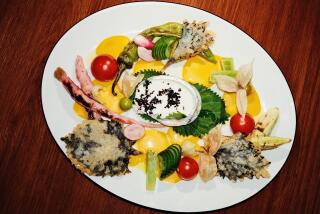Foreign correspondence: French chateau is home in ‘foie gras capital of the world’
- Share via
What’s it like to live in a far-off place most of us see only on a vacation? Foreign Correspondence is an interview with someone who lives in a spot you may want to visit.
Edmund Barton Bullock, 55, is a classical pianist, composer and recording artist (www.edmundbartonbullock.com). He is a native of North Carolina who since 1978 divides his time between the U.S. and France.
Q: Where are you currently living?
A. On the grounds of the Chateau de Palaminy, in southwest France. The owners of the castle are Marquis Robert and his wife, Jeanne-Marie de Palaminy. Robert’s ancestors were of the nobility; the family has owned it since 1720. The original part of the castle goes back to the 14th century.
They had a steward house they were refurbishing that was free. I moved there last summer.
Q: This is like the estate’s gatehouse?
A. It’s more like a steward’s residence. It’s big and has a just-finished music room that’s nearly 350 square feet with 11-foot ceilings. They’re rebuilding the 8-foot-high windows that are probably 150 years old — they’re the size of French doors.
The house is three levels and looks out on the castle and the park.
Q. The upkeep must be expensive. Is this a national trust thing?
A. It is privately owned, and subsidies are scarce. An ancestor was there at the time of the French Revolution and managed to stand down the townspeople; there was no killing there. Later ancestors were mayors of the town in the late 1800s and the first half of the last century.
There’s now a wing of the castle that contains six big bedrooms with a big living room and American kitchen. They rent it out (www.palaminy.com). The wing is rented by families. We’re only an hour from the Pyrenees; there are two or three major ski centers there.
Q: Are there ghosts in the gatehouse?
A. I haven’t had any real experiences at this place. There are legends here at Palaminy, but I’ve never stayed at the castle itself. It’s a Cathar castle that had a lot of history, so there must be manifestations.
The Cathars were a religious sect with many followers in the 13th century. They lived by the Gospel and were a big thorn to the Catholic Church. The Albigensian Crusade was proclaimed against them by the pope and led by King Louis VIII. Many Cathars were burned at the stake when they refused to renounce their faith. They inspired legends — that they had secrets connected to the Knights Templars.
Q: What’s the lay of the land? Are the chateau grounds fenced off like a ranch?
A. When you come to the little town, you cross a bridge over a canal and go through a big stone archway from the 1600s. On the right, where the town is, is the Garonne River. On the left you have the castle, and as you cross the bridge you can see a big stone wall. Pass the town and on the left is the big archway with gates to the castle. The steward’s house is next to it.
The grounds are really big. It takes 20 minutes to walk around the estate. It’s surrounded with a stone wall that’s 15 feet high at some points.
Q: Is this wine country?
A. The Fronton wine country is a one-hour drive north. This is, however, the foie gras capital of the world. Farmers raise geese and duck for it. A half hour or 45 minutes from here is a town called Samatan where you can buy fresh goose liver on Saturday mornings. It’s some of the best in the world. The prices are ridiculously cheap, though they go up at Christmas time.
Another town adjacent to Palaminy — Martres-Tolosane - is very famous for what they call “faience”: a special kind of glazed pottery.
Q: Do you get many tourists there?
A. Actually, yes. Also a lot of British who come to the area to live. The castle is only 35 minutes from the city of Toulouse by Interstate. Toulouse has one of the greatest orchestras in France. It’s part of the Languedoc heritage.
Q: That’s the medieval troubadour culture.
A. Absolutely. Its Academy of the Jeux Floraux — “Floral Games “ — was founded in 1323 by seven troubadours. It’s the oldest literary society in the Western world. It has 40 permanent members and I’ve become close with two of them. I have composed a song cycle about the history of the academy, beginning with the death of Raymond VII of Toulouse, the last count of Languedoc, who lived in the time of the Cathars.
Q: Do you have a lute?
A. For the song cycle, I used the modal language of that period, but transcribed it for modern voice and piano.
No, I don’t own a lute yet, but who knows?
———
Know someone who lives in an interesting city or country who would like to give us the inside line on visiting there? Email, in English, [email protected].
More to Read
Sign up for The Wild
We’ll help you find the best places to hike, bike and run, as well as the perfect silent spots for meditation and yoga.
You may occasionally receive promotional content from the Los Angeles Times.






